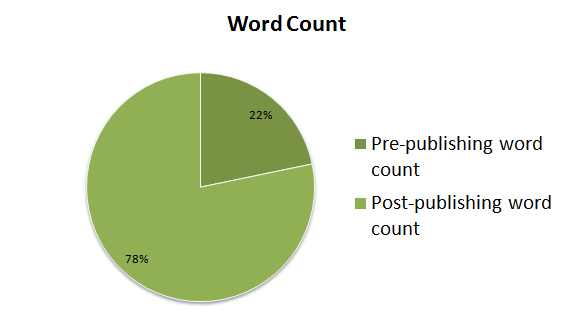Post-Publishing Word Count Can Be Three Times as Long
Recently I've been playing more of a blogger role at my job, doing more user awareness than user education. This will only increase during the coming months, and if I do a good job, I might finally show the importance of this neglected role.
Part of the reason we're doing more user awareness is because we've suddenly published dozens of new websites, tools, and other technical solutions, and we're trying to help the general membership come up to speed with what's new.
As a strategy for user awareness, some leaders made a list of topics they want me to emphasize in regular web articles over the coming year. In determining a cost/time estimate, I've decided to account for post-publishing time as well, since merely publishing articles no longer addresses the whole time involved in writing.
The time involved in writing an article or a post depends on how many comments and responses you get from readers. After you publish an article and send the link across Twitter, Facebook, and other channels, comments start to pour in. Users may respond in comments below the article (if you have a comments feature), or they may respond on Twitter, Facebook, forums, email messages, in their own blog posts, and other ways. It's the writer's responsibility to respond to feedback where necessary.
Sometimes the post-publishing word count is actually longer than the pre-publishing word count. For example, my post on the enterprise help authoring problem was about 500 words long. However, the post received more than 30 comments. I responded to many of these comments. The total word count of just my own responses was about 1,800 words -- more than three times the length of the original post! In this case, the bulk of the writing for the post came in the post-publishing phase.

Granted, making a comment doesn't often require the same effort as writing the original article, but there is still time involved. The number of responses required also depends on how I comment. Sometimes my comments elicit new responses from readers (it's a conversation, remember), so the response length can increase even more.
Twitter and Facebook Conversations
Conversations also take place over Twitter and Facebook. For example, last week I published an article about a crowdsourcing site my organization created. I included the #lds hashtag on the tweet, and as a result, the tweet was retweeted 20 times, with a total reach of about 6,600 people according to Tweetreach.

Tweetreach lists all the people who mentioned the article. It would be good to at least read these retweets to see if the readers have questions or responses or other comments on the article. Many people on Twitter simply retweet the link, which doesn't require a response. But a good social media strategy would probably have me follow the people who retweet the content, or at least take note of the Twitter audience. The same applies to Facebook.
My basic point is that the time estimate for writing should include both pre-publishing time and post-publishing time. I've written similarly how technical writers should not consider a help file complete when it's initially published. Help is in a state of perpetual beta -- you're always improving the information as questions, problems, bugs, and other issues come to light.
Worth the Effort?
One problem with this heavy post-publishing model is that responding to comments often constitutes a one-to-one effort, whereas writing the article is a one-to-many effort. The payoff for writing the article affects 80 percent of the users, whereas the payoff for responding to comments only affects about 20 percent of the users. At some point, you may be expending a lot of effort responding to individual comments without having much payoff for that time. Because of this, it's probably best to not spend time responding to every comment -- just the ones that seem to need a response.
Real Time Approval?
Another aspect to consider with the post-publishing word count is approval. When writing content in a corporation, much of this content has to go through several approval processes before it's published. For example, you may need approval from the product manager, the communications director, the intellectual property department, and the website owner before publishing. The original article is highly scrutinized.
But what about approval processes for the post-published content? Remember this content may be three times as long as the original article. Should each of these comments go through approval as well?
Post-publishing activities in social media channels cannot go through the same approval processes because there's an entirely different dynamic and time constraint on the content. Conversations take place in near real-time. Companies should just assume some risk by allowing writers to respond with their own judgment on articles. The risk of a poor comment is lower than the risk of not responding at all (or not responding in a timely way). I'll probably address real-time engagement in a future post.
Overall, not a lot has been written about post-publishing process and efforts, but this is an area that deserves more attention.
About Tom Johnson

I'm an API technical writer based in the Seattle area. On this blog, I write about topics related to technical writing and communication — such as software documentation, API documentation, AI, information architecture, content strategy, writing processes, plain language, tech comm careers, and more. Check out my API documentation course if you're looking for more info about documenting APIs. Or see my posts on AI and AI course section for more on the latest in AI and tech comm.
If you're a technical writer and want to keep on top of the latest trends in the tech comm, be sure to subscribe to email updates below. You can also learn more about me or contact me. Finally, note that the opinions I express on my blog are my own points of view, not that of my employer.
